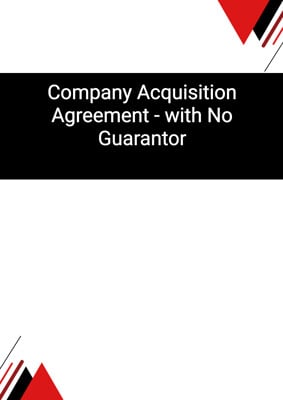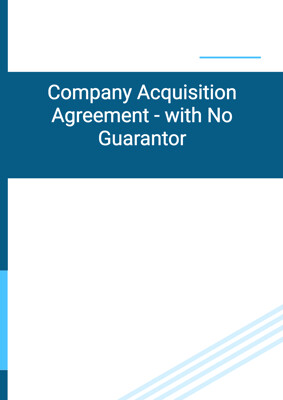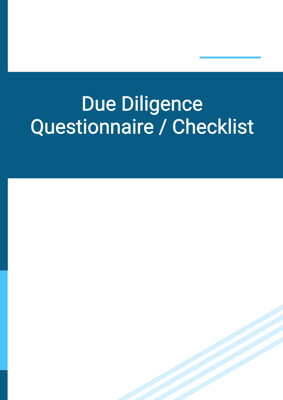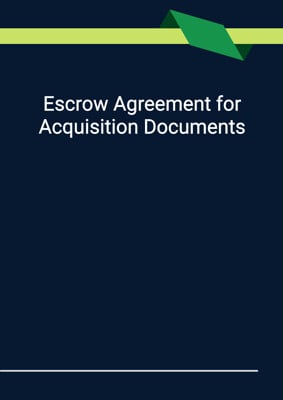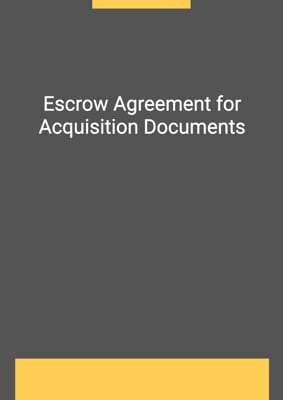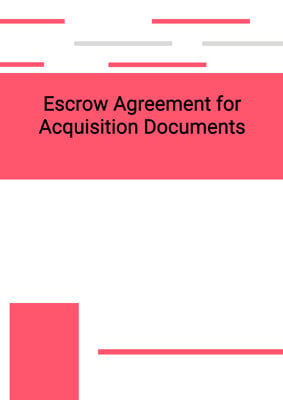How to Tailor the Document for Your Need?
01
Create Document
Click "Create Document" button and the document will be prepared with your account details automatically filled in.
02
Fill Information
Please fill in any additional information by following the step-by-step guide on the left hand side of the preview document and click the "Next" button.
03
Get Document
When you are done, click the "Get Document" button and you can download the document in Word or PDF format.
04
Review Document
Please review the document carefully and make any final modifications to ensure that the details are correct before publication / distribution.
Document Preview
Document Description
The document titled 'Introduction to Sale and Acquisition of Asset / Business / Company' provides a comprehensive overview of the sale and purchase of business or company acquisition agreements. It is important to understand the significance of this document as it serves as a guide for individuals who are involved in such transactions. The document begins with a disclaimer stating that it is a general summary and does not constitute legal advice. It emphasizes the need for individuals to consult with their local lawyer as each jurisdiction may have different regulations.
The document provides a summary of various templates and agreements related to the sale and purchase of assets, business, and company acquisition. It includes a table that serves as a quick reference guide for determining which document to use in different situations. The document covers a wide range of agreements including non-disclosure agreements, memorandums of understanding, feasibility studies, business acquisition agreements, warranties, disclosure letters, due diligence questionnaires, and more.
The document highlights the importance of due diligence in the acquisition process. It explains that buyers should thoroughly investigate the state of the asset, business, or company before committing to the terms of the acquisition. Due diligence helps in understanding the business, identifying potential risks, and renegotiating terms if necessary. The document also emphasizes the significance of warranties and representations made by the seller. These warranties provide protection to the buyer in case any of the representations turn out to be incorrect. The seller may make disclosures against the warranties to prevent the buyer from claiming in respect of the disclosed matter.
The document further discusses the acquisition of assets and the acquisition of a business separately. It explains the advantages and disadvantages of each approach. Acquiring assets provides flexibility to the buyer in choosing the assets and excluding liabilities not associated with the target business. It also helps in avoiding contingent liabilities and insolvency issues. On the other hand, acquiring a business involves taking over all the assets and liabilities of the target business. The document highlights operational issues, employment complications, and tax implications associated with both approaches.
In the section on business acquisition, the document emphasizes the importance of confidentiality and the use of a memorandum of understanding (MOU). A confidentiality undertaking is often required at the start of a sale process to protect confidential information and keep the sale negotiations confidential. An MOU serves as a non-legally binding record of the main terms of the deal agreed between the buyer and seller. It may include an exclusivity provision to prevent either party from negotiating or soliciting other offers during a specified period.
The document also covers various other aspects of the acquisition process such as regulatory approvals, tax considerations, property, intellectual property, information technology, environmental issues, insurance, customers and suppliers, debtors and creditors, employment, pensions, notifications, and more. It provides guidance on each of these areas and highlights the key factors to consider.
Overall, this document serves as a comprehensive guide for individuals involved in the sale and acquisition of assets, business, or company. It provides detailed information on the various agreements, processes, and considerations involved in such transactions.
How to use this document?
1. Conduct due diligence: Before committing to the terms of the acquisition, it is crucial to thoroughly investigate the state of the asset, business, or company. This includes understanding the business, identifying potential risks, and renegotiating terms if necessary.
2. Understand warranties and representations: Pay close attention to the warranties and representations made by the seller. These provide protection to the buyer in case any of the representations turn out to be incorrect. The seller may make disclosures against the warranties to prevent the buyer from claiming in respect of the disclosed matter.
3. Choose between asset acquisition and business acquisition: Consider the advantages and disadvantages of acquiring assets versus acquiring a business. Acquiring assets provides flexibility in choosing specific assets and excluding liabilities not associated with the target business. Acquiring a business involves taking over all the assets and liabilities of the target business.
4. Maintain confidentiality: At the start of the sale process, the seller may require the buyer to enter into a confidentiality undertaking. This is important to protect confidential information about the business and keep the sale negotiations confidential.
5. Consider a memorandum of understanding (MOU): If the buyer and seller reach agreement in principle on the deal, they may enter into an MOU. This serves as a non-legally binding record of the main terms of the deal and may include an exclusivity provision.
6. Obtain necessary regulatory approvals: Depending on the nature of the acquisition, it may require approval from local regulatory authorities. Ensure that all necessary approvals are obtained before proceeding with the transaction.
7. Consider tax implications: Understand the tax implications of the acquisition, including corporation tax on chargeable gains, VAT, stamp duty, and other relevant taxes. Consult with a local tax advisor to ensure compliance.
8. Conduct property and environmental assessments: If the acquisition involves real property, conduct thorough property searches and investigations. Consider environmental implications and compliance with environmental laws. Obtain necessary permits and consents.
9. Address employment considerations: If the acquisition involves the transfer of employees, comply with legal obligations regarding informing and consulting employees. Consider any changes to working practices or terms and conditions of employment.
10. Review and negotiate contracts: Identify key contracts and determine how they will be transferred. Consider novation or assignment options and obtain necessary consents. Protect against undisclosed onerous liabilities.
11. Address debtors and creditors: Determine how debtors and creditors will be handled in the acquisition. Consider options such as assignment of debtors, assumption of liabilities, or transitional arrangements for debt collection and payment.
12. Evaluate intellectual property rights: Identify the intellectual property rights relevant to the business being acquired. Determine ownership and licensing arrangements. Consider the transferability of licenses and the need for consent from licensors.
13. Address information technology and data protection: Identify IT assets and arrangements that are important to the business being sold. Determine if computer systems need to be transferred or if transitional access arrangements can be negotiated. Ensure compliance with data protection laws.
14. Consider insurance coverage: Assess the insurance coverage for the assets being acquired. Determine if additional insurance or warranties are necessary to protect against potential risks.
15. Plan for completion: Prepare a completion agenda to identify the documents to be prepared, the resolutions to pass, and the persons required to execute documents. Ensure that all conditions precedent to completion are satisfied.
16. Address post-completion tasks: Register any necessary charges within the deadline. Consider any circulars or filings required. Bring statutory books up to date and ensure compliance with post-completion obligations.
17. Seek professional advice: Throughout the acquisition process, consult with legal advisors, accountants, and other professionals to ensure compliance with regulations and to address any specific concerns or complexities related to the transaction.
Not the right document?
Don’t worry, we have thousands of documents for you to choose from:








































